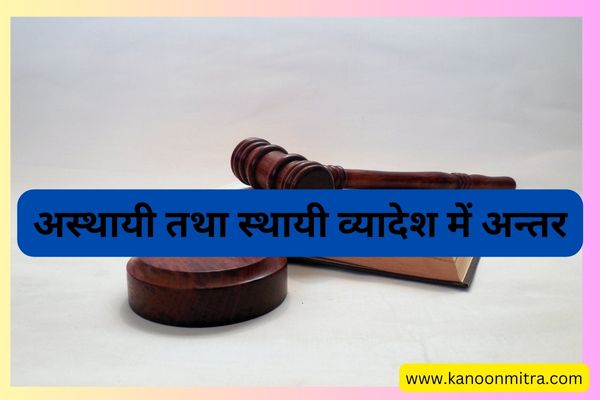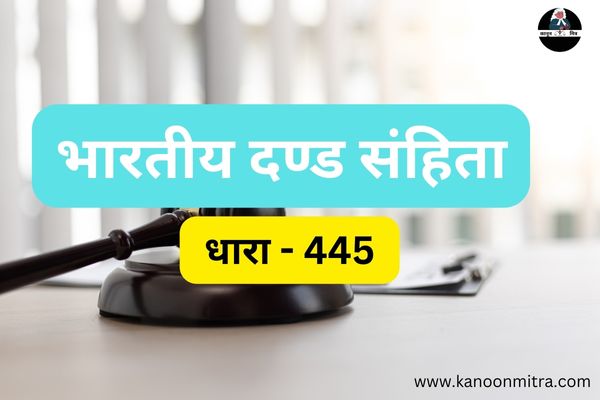IPC की धारा 464 — मिथ्या दस्तावेज रचना –
उस व्यक्ति के बारे में यह कहा जाता है कि वह व्यक्ति मिथ्या दस्तावेज या मिथ्या इलेक्ट्रॉनिक अभिलेख रचता है –
पहला — जो बेईमानी से या कपटपूर्वक इस आशय से —
(क) किसी दस्तावेज को या दस्तावेज के भाग को रचित, हस्ताक्षरित, मुद्रांकित या निष्पादित करता है;
(ख) किसी इलेक्ट्रॉनिक अभिलेख को या इलेक्ट्रॉनिक अभिलेख के भाग को रचित या सम्प्रेषित करता है;
(ग) किसी इलेक्ट्रॉनिक अभिलेख पर कोई इलेक्ट्रॉनिक चिह्नक करता है;
(घ) किसी दस्तावेज का निष्पादन या इलेक्ट्रॉनिक चिह्नक की प्रमाणिकता द्योतन करने वाला कोई चिन्ह लगाता है, कि यह विश्वास किया जाए कि ऐसी दस्तावेज या दस्तावेज के भाग, इलेक्ट्रॉनिक अभिलेख या इलेक्ट्रॉनिक चिह्नक की रचना, हस्ताक्षरण, मुद्रांकन, निष्पादन, सम्प्रेषण या संयोजन ऐसे व्यक्ति द्वारा या ऐसे व्यक्ति के प्राधिकार द्वारा किया गया था, जिसके द्वारा या जिसके प्राधिकार द्वारा उसकी रचना, हस्ताक्षरण, मुद्रांकन या निष्पादन, सम्प्रेषण या संयोजन न होने की बात वह जानता है; अथवा
दूसरा — जो किसी दस्तावेज या इलेक्ट्रॉनिक अभिलेख के किसी तात्विक भाग में परिवर्तन, उसके द्वारा या किसी अन्य व्यक्ति द्वारा, चाहे ऐसा व्यक्ति ऐसे परिवर्तन के समय जीवित हो या नहीं, उस दस्तावेज या इलेक्ट्रॉनिक अभिलेख के रचित, निष्पादित या इलेक्ट्रॉनिक चिह्नक से संयोजित किये जाने के पश्चात् उसे रद्द करने द्वारा या अन्यथा, विधिपूर्वक प्राधिकार के बिना बेईमानी से या कपटपूर्वक करता है; अथवा
तीसरा – जो किसी व्यक्ति द्वारा, यह जानते हुए कि ऐसा व्यक्ति दस्तावेज या इलेक्ट्रॉनिक अभिलेख की विषय वस्तु को परिवर्तन के रूप को, चित्तविकृति या मत्तता की हालत में होने के कारण जान नहीं सकता या उस प्रवंचना के कारण, जो उससे की गई है, जानता नहीं है, उस दस्तावेज या इलेक्ट्रॉनिक अभिलेख को बेईमानी से, या कपटपूर्वक हस्ताक्षरित, मुद्रांकित, निष्पादित या परिवर्तित किया जाना या इलेक्ट्रॉनिक अभिलेख पर अपने इलेक्ट्रॉनिक चिह्नक किया जाना कारित करता है;
दृष्टांत –
(क) क के पास य द्वारा ख पर लिखा हुआ 10,000 रुपए का एक प्रत्ययपत्र है। ख से कपट करने के लिए क 10,000 रुपए में एक शून्य बढ़ा देता है और उस राशि को 1,00,000 रु. इस आशय से बना देता है कि ख यह विश्वास कर ले कि य ने वह पत्र ऐसा ही लिखा था क ने कूटरचना की है।
(ख) क, इस आशय से कि वह य की सम्पदा ख को बेच दे और उसके द्वारा ख से क्रय धन अभिप्राप्त कर ले य के प्राधिकार के बिना य की मुद्रा एक ऐसी दस्तावेज पर लगाता है, जो कि य की ओर से क की सम्पदा का हस्तांतरण-पत्र होना तात्पर्यित है। क ने कूटरचना की है।
(ग) एक बैंकर पर लिखे हुए और वाहक को देय चैक को क उठा लेता है। चैक ख द्वारा हस्ताक्षरित है, किन्तु उस चैक में कोई राशि अंकित नहीं है। क दस हजार रुपए की राशि अंकित करके चैक को कपटपूर्वक भर लेता है। क कूटरचना करता है।
(घ) क अपने अभिकर्ता ख के पास एक बैंकर पर लिखा हुआ, क द्वारा हस्ताक्षरित चैक, देय धनराशि अंकित किए बिना छोड़ देता है। ख को क इस बात के लिए प्राधिकृत कर देता है कि वह कुछ संदाय करने के लिए चैक में ऐसी धनराशि, जो दस हजार रुपए से अधिक न हो, अंकित करके चैक भर ले। ख कपटपूर्वक चैक में बीस हजार रुपए अंकित करके उसे भर लेता है। ख कूटरचना करता है।
(ङ) क, ख के प्राधिकार के बिना ख के नाम में अपने ऊपर एक विनिमयपत्र इस आशय से लिखता है कि वह एक बैंकार से नकदी विनिमयपत्र की भांति बट्टा देकर उसे भुना ले, और उस विनिमयपत्र को उसकी परिपक्वता पर ले ले। यहां क इस आशय से उस विनिमयपत्र को लिखता है कि प्रवंचना करके बैंकार को यह अनुमान करा दे कि उसे ख की प्रतिभूति प्राप्त है, और इसलिए वह उस विनिमयपत्र को बट्टा लेकर भुना दे। क कूटरचना का दोषी है।
(च) य की विल में ये शब्द अन्तर्विष्ट हैं कि “मैं निदेश देता हूं कि मेरी समस्त शेष संपत्ति क, ख और ग में बराबर बांट दी जाए।” क बेईमानी से ख का नाम इस आशय से खुरच डालता है कि यह विश्वास कर लिया जाए कि समस्त संपत्ति उसके स्वयं के लिए और ग के लिए ही छोड़ी गई थी। क ने कूट रचना की है।
(छ) क एक सरकारी वचनपत्र को, पृष्ठांकित करता है और उस पर शब्द “य को उसके आदेशानुसार दे दो” लिखकर और पृष्ठांकन पर हस्ताक्षर करके उसे य को या उसके आदेशानुसार देय कर देता है। ख बेईमानी से “य को या उसके आदेशानुसार दे दो” इन शब्दों को छीलकर मिटा डालता है, और इस प्रकार उस विशेष पृष्ठांकन को एक निरंक पृष्ठांकन में परिवर्तित कर देता है। ख कूटरचना करता है।
(ज) क एक सम्पदा य को बेच देता है और उसका हस्तांतर पत्र लिख देता है। उसके पश्चात् क, य को कपट करके संपदा से वंचित करने के लिए उसी सम्पदा का एक हस्तांतर पत्र, जिस पर य के हस्तांतर-पत्र की तारीख से छह मास पूर्व की तारीख पड़ी हुई है, ख के नाम इस आशय से निष्पादित कर देता है कि यह विश्वास कर लिया जाए कि उसने अपनी संपदा य को हस्तांतरित करने से पूर्व ख को हस्तांतरित कर दी थी। क ने कूटरचना की है।
(झ) य अपनी विल क से लिखवाता है। क साशय एक ऐसे वसीयतदार का नाम लिख देता है जो कि उस वसीयतदार से भिन्न है, जिसका नाम य ने कहा है, और य को यह व्यपदिष्ट करके कि उसने विल उसके अनुदेशों के अनुसार ही तैयार की है, य को विल पर हस्ताक्षर करने के लिए उत्प्रेरित करता है। क ने कूटरचना की है।
(ञ) क एक पत्र लिखता है और ख के प्राधिकार के बिना, इस आशय से कि उस पत्र के द्वारा य से और अन्य व्यक्तियों से भिक्षा अभिप्राप्त करे, ख के नाम से हस्ताक्षर यह प्रमाणित करते हुए कर देता है कि क अच्छे शील का व्यक्ति है और अनवेक्षित दुर्भाग्य के कारण दीन अवस्था में है। यहां क ने य को संपत्ति अलग करने के लिए उत्प्रेरित करने की मिथ्या दस्तावेज रची है, इसलिए क ने कूटरचना की है।
(ट) ख के प्राधिकार के बिना क इस आशय से कि उसके द्वारा य के अधीन नौकरी अभिप्राप्त करे, क के शील को प्रमाणित करते हुए एक पत्र लिखता है, और उसे ख के नाम से हस्ताक्षरित करता है। क ने कूट रचना की है क्योंकि उसका आशय कूटरचित प्रमाण-पत्र द्वारा य को प्रवंचित करने का और ऐसा करके य को सेवा की अभिव्यक्त या विवक्षित संविदा में प्रविष्ट होने के लिए उत्प्रेरित करने का था।
स्पष्टीकरण 1 – किसी व्यक्ति का स्वयं अपने नाम का हस्ताक्षर करना कूटरचना की कोटि में आ सकेगा।
दृष्टांत –
(क) क एक विनिमयपत्र पर अपने हस्ताक्षर इस आशय से करता है कि यह विश्वास कर लिया जाए कि वह विनिमयपत्र उसी नाम के किसी अन्य व्यक्ति द्वारा लिखा गया था। क ने कूटरचना की है।
(ख) क एक कागज के टुकड़े पर शब्द “प्रतिगृहीत किया” लिखता है और उस पर य के नाम के हस्ताक्षर इसलिए करता है कि ख बाद में इस कागज पर एक विनियमपत्र, जो ख ने य के ऊपर किया है, लिखे और उस विनिमयपत्र का इस प्रकार परक्रामण करे, मानो वह य के द्वारा प्रतिगृहीत कर लिया गया था। क कूटरचना का दोषी है, तथा यदि ख इस तथ्य को जानते हुए क के आशय के अनुसरण में, उस कागज पर विनिमयपत्र लिख देता है, तो ख भी कूटरचना का दोषी है।
(ग) क अपने नाम के किसी अन्य व्यक्ति के आदेशानुसार देय विनिमयपत्र पड़ा पाता है। क उसे उठा लेता है और यह विश्वास कराने के आशय से स्वयं अपने नाम पृष्ठांकित करता है कि इस विनिमयपत्र पर पृष्ठांकन उसी व्यक्ति द्वारा लिखा गया था जिसके आदेशानुसार वह देय है। यहां क ने कूटरचना की है।
(घ) क, ख के विरुद्ध एक डिक्री के निष्पादन में बेची गई संपदा को खरीदता है। ख संपदा के अभिगृहीत किए जाने के पश्चात् य के साथ दुस्संधि करके क को कपट वंचित करने और यह विश्वास कराने के आशय से कि वह पट्टा अभिग्रहण से पूर्व निष्पादित किया गया था, नाममात्र के भाटक पर और एक लंबी कालावधि के लिए य के नाम उस संपदा का पट्टा कर देता है और पट्टे पर अभिग्रहण से छह मास पूर्व की तारीख डाल देता है। ख यद्यपि पट्टे का निष्पादन स्वयं अपने नाम से करता है, तथापि उस पर पूर्व की तारीख डालकर वह कूटरचना करता है।
(ङ) क एक व्यापारी अपने दिवाले का पूर्वानुमान करके अपनी चीजवस्तु ख के पास क के फायदे के लिए और अपने लेनदारों को कपट से वंचित करने के आशय से रख देता है और प्राप्त मूल्य के बदले में, ख को एक धनराशि देने के लिए अपने को आबद्ध करते हुए, एक वचनपत्र उस संव्यवहार की सच्चाई की रंगत देने के लिए लिख देता है, और इस आशय से कि यह विश्वास कर लिया जाए कि यह वचनपत्र उसने उस समय से पूर्व ही लिखा था जब उसका दिवाला निकलने वाला था, उस पर पहले की तारीख डाल देता है। क ने परिभाषा के प्रथम शीर्षक के अधीन कूटरचना की है।
स्पष्टीकरण 2 – कोई मिथ्या दस्तावेज किसी कल्पित व्यक्ति के नाम से इस आशय से रचना कि यह विश्वास कर लिया जाए कि वह दस्तावेज एक वास्तविक व्यक्ति द्वारा रची गई थी, या किसी मृत व्यक्ति के नाम से इस आशय से रचना कि यह विश्वास कर लिया जाए कि वह दस्तावेज उस व्यक्ति द्वारा उसके जीवनकाल में रची गई थी, कूटरचना की कोटि में आ सकेगा।
दृष्टांत –
क एक कल्पित व्यक्ति के नाम कोई विनिमयपत्र लिखता है, और उसका परक्रामण करने के आशय से उस विनिमयपत्र को ऐसे कल्पित व्यक्ति के नाम से कपटपूर्वक प्रतिगृहीत कर लेता है। क कूटरचना करता है।
स्पष्टीकरण 3 – इस धारा के प्रयोजनों के लिए “इलेक्ट्रॉनिक चिह्नक करना” अभिव्यक्ति का वही अर्थ होगा जो उसे सूचना प्रौद्योगिकी अधिनियम, 2000 (2000 का 21) की धारा 2 की उपधारा (1) के खण्ड (घ) में समनुदेशित है।
IPC Section 464 — Making a false document –
A person is said to make a false document or false electronic record –
First – Who dishonestly or fradulently –
(a) makes, signs, seals or executes a document or part of a document;
(b) makes or transmits any electronic record or part of any electronic S record;
(c) affixes any electronic signature] on any electronic record;
(d) makes any mark denoting the execution of a document or the authenticity of the selectronic signature], with the intention of causing it to be believed that such document or part of document, electronic record or [electronic signature] was made, signed, sealed, executed, transmitted or affixed by or by the authority of a person by whom or by whose authority he knows that it was not made, signed, sealed, executed or affixed; or
Secondly – Who, without lawful authority, dishonestly or fraudulently, by cancellation or otherwise, alters a document or an electronic record in any material part thereof, after it has been made, executed or affixed with electronic signature either by himself or by any other person, whether such person be living or dead at the time of such alteration; or
Thirdly – Who dishonestly or fraudulently causes any person to sign, seal, execute or alter a document or an electronic record or to affix his electronic signature on any electronic record knowing that such person by reason of unsoundness of mind or intoxication cannot, or that by reason of deception practised upon him, he does not know the contents of the document or electronic record or the nature of the alteration.
Illustrations –
(a) A has a letter of credit upon B for rupees 10,000 written by Z. A, in order to defraud B, adds a cipher to the 10,000, and makes the sum 1,00,000 intending that it may be believed by B that Z so wrote the letter. A has committed forgery
(b) A, without Z’s authority, affixes Z’s seal to a document purporting to be a conveyance of an estate from Z to A, with the intention of selling the estate to B, and thereby of obtaining from B the purchase-money. A has committed forgery.
(c) A picks up a cheque on a banker signed by B, payable to bearer, but without any sum having been inserted in the cheque. A fraudulently fills up the cheque by inserting the sum of ten thousand rupees. A commits forgery.
(d) A leaves with B, his agent, a cheque on a banker, signed by A, without inserting the sum payable and authorizes B to fill up the cheque by inserting a sum not exceeding ten thousand rupees for the purpose of making certain payment. B fraudulently fills up the cheque by inserting the sum of twenty thousand rupees. B commits forgery.
(e) A draws a bill of exchange on himself in the name of B without B’s authority, intending to discount it as a genuine bill with a banker and intending to take up the bill on its maturity. Here, as A draws the bill with intent to deceive the banker by leading him to suppose that he had the security of B, and thereby to discount the bill, A is guilty of forgery.
(f) Z’s Will contains these words — “I direct that all my remaining property be equally divided between A, B and C.” A dishonestly scratches out B’s name, intending that it may be believed that the whole was left to himself and C. A has committed forgery.
(g) A endorses a Government promissory note and makes it payable to Z or his order by writing on the bill the words “Pay to Z or his order” and signing the endorsement. B dishonestly erases the words “Pay to Z or his order”, and thereby converts the special endorsement into a blank endorsement. B commits forgery.
(h) A sells and conveys an estate to Z. A afterwards, in order to defraud Z of his estate, executes a conveyance of the same estate to B, dated six months earlier than the date of the conveyance to Z, intending it to be believed that he had conveyed the estate to B before he conveyed it to Z. A has committed forgery.
(i) Z dictates his Will to A. A intentionally writes down a different legatee from the legatee named by Z, and by representing to Z that he has prepared the Will according to his instructions, induces Z to sign the Will. A has committed forgery.
(j) A writes a letter and signs it with B’s name without B’s authority, certifying that A is a man of good character and in distressed circumstances from unforeseen misfortune, intending by means of such letter to obtain alms from Z and other persons. Here, as A made a false document in order to induce Z to part with property. A has committed forgery.
(k) A without B’s authority writes a letter and signs it in B’s name certifying to A’s character, intending thereby to obtain employment under Z. A has committed forgery inasmuch as he intended to deceive Z by the forged certificate, and thereby to induce Z to enter into an express or implied contract for service.
Explanation 1 – A man’s signature of his own name may amount to forgery.
Illustrations –
(a) A signs his own name to a bill of exchange, intending that it may be believed that the bill was drawn by another person of the same name. A has committed forgery.
(b) A writes the word “accepted” on a piece of paper and signs it with Z’s name, in order that B may afterwards write on the paper a bill of exchange drawn by B upon Z, and negotiate the bill as though it had been accepted by Z. A is guilty of forgery; and if B, knowing the fact, draws the bill upon the paper pursuant to A’s intention, B is also guilty of forgery.
(c) A picks up a bill of exchange payable to the order of a different person of the same name. A endorses the bill in his own name, intending to cause it to be believed that it was endorsed by the person whose order it was payable; here A has committed forgery.
(d) A purchases an estate sold under execution of a decree against B. B, after the seizure of the estate, in collusion with Z, executes a lease of the estate to Z at a nominal rent and for a long period and dates the lease six months prior to the seizure, with intent to defraud A, and to cause it to be believed that the lease was granted before the seizure. B, though he executes the lease in his own name, commits forgery by antedating it.
(e) A, a trader, in anticipation of insolvency, lodges effects with B for A’s benefit, and with intent to defraud his creditors; and in order to give a color to the transaction, writes a promissory note binding himself to pay to B a sum for value received, and antedates the note, intending that it may be believed to have been made before A was on the point of insolvency. A has committed forgery under the first head of the definition.
Explanation 2 – The making of a false document in the name of a fictitious person, intending it to be believed that the document was made by a real person, or in the name of a deceased person, intending it to be believed that the document was made by the person in his lifetime, may amount to forgery.
Illustration –
A draws a bill of exchange upon a fictitious person, and fraudulently accepts the bill in the name of such fictitious person with intent to negotiate it. A commits forgery.
Explanation 3 – For the purposes of this section, the expression “affixing [electronic signature]” shall have the meaning assigned to it in clause (d) of sub-section (1) of section 2 of the Information Technology Act, 2000 (21 of 2000).
IPC की धारा 464




